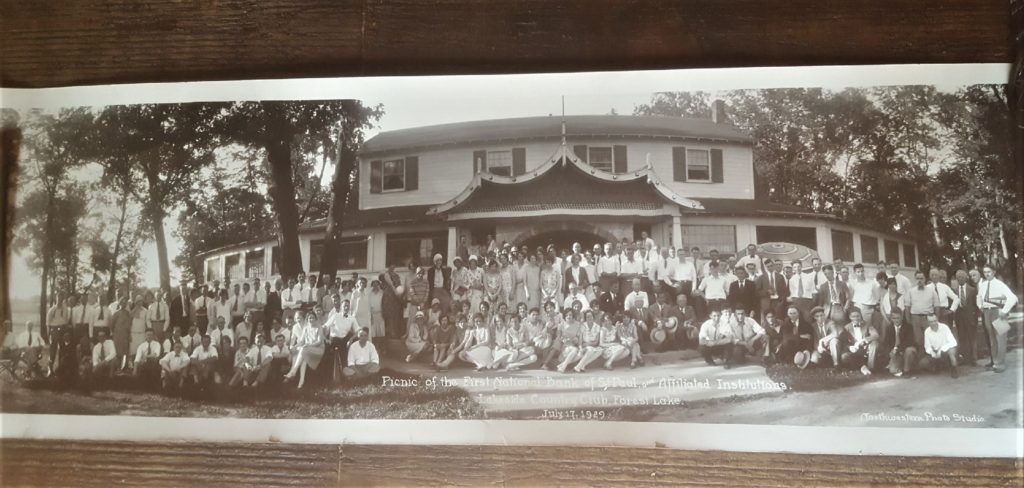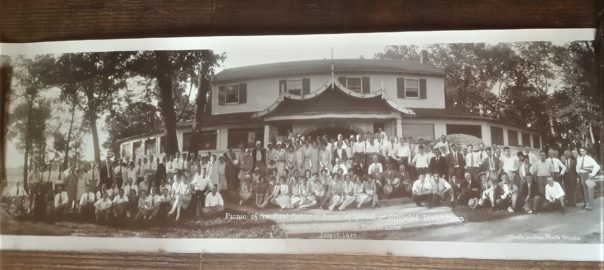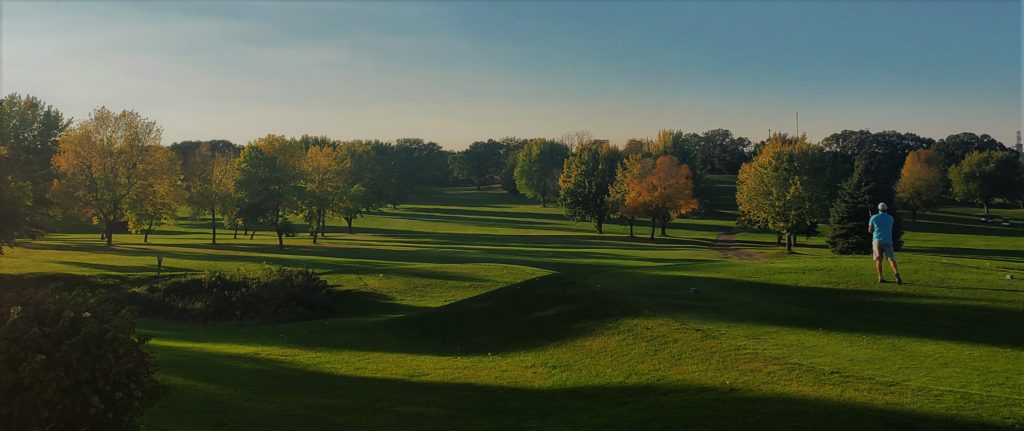2021 was a banner year for Minnesota golf courses. For lost courses? Not so much.
Cumulatively, that’s a very good thing.
Regarding the former, Minnesotans played a lot of golf in 2021. And then they played more. A December news release by the Minnesota Golf Association set the increase in rounds played across the state at 6.9 percent for the year, with 1.6 million rounds played by MGA members alone. That’s on the heels of a 2020 season in which rounds surged upward by 31.5 percent, driven largely by pandemic restrictions placed on other outdoor activities.
A residual effect from the past two years? Fewer lost golf courses. I can’t unequivocally say that one phenomenon (more golf) contributed to the other (fewer lost courses), but the connection seems obvious. As far as I know, only two Minnesota courses permanently shut down in 2021: The Ponds at Battle Creek in Maplewood (established 2004) and Rich Valley in Rosemount (pictured below, established 1998). It’s entirely possible there were more, though, and if you know of others, please let me know, if only so I can keep my lost-course map and list of courses that have closed since 2000 as up to date as possible.
Rich Valley Golf Course, Rosemount, October 2021, weeks before permanent closure. The course had been in the Ray Rahn family since its inception in 1998. The family also designed and established Parkview in Eagan (now a lost course) and Fountain Valley in Farmington, which was sold in 1980. Sadly, it was reported on Rich Valley’s Facebook page that some pathetic soul or souls made off with a handful of Rich Valley’s tee markers in the club’s final month. The family deserves to have them back, so ‘fess up.
That the roll of Minnesota lost courses grew by only two is significant. The trend toward losing courses left and right, north and south, hill and valley, has slowed appreciably. Two more in 2021 makes for a total of 85 since 2000. But the 2021 total was a small increase, and if you ask me, it signals the slowing of a market correction that began shortly after 2000, when it became clear the course-building boom of the 1990s had oversupplied Minnesota with golf venues, and nearly two decades of shuttering began.
Self-reflection
On a personal note, 2021 was my slowest year in golf since I was about 6, i.e. 171 years ago. When I was 7, when my dad sawed off a hickory-shafted 2-iron, wrapped electrical tape around the shaft (what other kind of tape would an electrician use?) and handed it to me, and off I went. My previous posts on this blog this year total exactly one. Two reasons: One, after spending a decade identifying, researching and writing about 231 lost courses in one state alone, I am left feeling a bit spent on the subject; and two, because of the pandemic, access to the Minnesota History Center, where I have done most of my research since about 2016, has been severely limited (only one visit this year).
I will, however gladly pass on a few nuggets from 2021, in this post and the next.
Forest Lake origins
Erik Espe of Baxter, a keen Minnesota golf history aficiando, passed along the photo below, inscribed “Picnic of the First National Bank of St. Paul, and Affiliated Institutions. Lakeside Country Club, Forest Lake. July 17, 1929.” (Click on the image for a closer look.) He wondered if I had any familiarity with the place, and I answered that I had little certain knowledge.

Some digging revealed a few details, albeit not a complete story. Spoiler alert: This place is not a lost course.
To amplify Espe’s inquiry, what and/or where was Forest Lake Country Club?
I knew that the consensus of citations on the origins of golf in Forest Lake place Castlewood, a nine-hole public course not far off the south shore of Forest Lake, as having been established in the 1920s, and Forest Hills Golf Club, an 18-hole private just a half-mile to the southeast, as established in 1962.
The Forest Hills opening date is essentially not in dispute, though I’ve seen claims of starting dates as early as 1958 and as late as 1968 (and the club’s website doesn’t really help, considering its “Our History” tab features no information). But it isn’t Forest Hills that captures my particular interest. It’s Forest Hills’ northern neighbor that does.
Castlewood, also known today as “The Rock,” was established in 1920, according to the club’s website. There are, however, multiple sources that claim starting dates of 1925 or 1927. Here is where I issue a large caveat and asterisk: Without access to the History Center and local newspaper archives, I can’t say for sure which year is correct — if either.
But I can guess, and I’m guessing 1927 is the best guess. Among websites listing that starting date, GolfLink gets a shout-out from me.
I conducted searches of online Minnesota newspaper archives, most prominently the Minneapolis Tribune and Minneapolis Star, and could not come up with a reference to a golf course in Forest Lake in 1925 or before. When I reset the search parameters to 1930 or before, there were many results, including this:
“Forest Lake Club to Open Nine-Hole Course Next Month,” read the headline in the Minneapolis Tribune of April 13, 1927.
Text from the story: “The course, situated on the south short of Forest lake, was begun under the promotion of J. M. Hegge last year when fairways were graded and seeded. Work of installing sand greens is under way and is expected to be completed within 30 days. Grass greens will be substituted as soon as practicable.
“A $100,000 club house has been built and several cottages are provided for vacationists. Barney Carlson, former pro at Phalen, will have charge of the course.”
This is not to say there couldn’t have been a golf course on the Castlewood site or elsewhere in Forest Lake before 1927, but the Tribune story suggests that is the year organized golf was first played in the city.
In the Tribune story, the reference to the clubhouse is telling. A hundred grand would have bought you a lot of clubhouse in 1927, a lot more than, say, a shack with a rusty mower, a cooler full of ale and sarsaparilla, a card table and three rickety chairs. Look again at Espe’s photo, and you get what most certainly was your $100,000 clubhouse along the shore of Forest Lake (a body of water is visible in the photo’s background).
As for the reference to Lakeside Country Club? The Tribune of April 21, 1929, enlightens:
“The Lakeside Country club at Forest Lake, operating a public course for the past two seasons, will be opened April 27 as a private club. The nine-hole course which measures 3,555 yards is in excellent condition, witht (sic) fine fairways and grass greens. The club has a membership of 350.”
Further digging revealed a smattering of newspaper stories about the golf course and considerably more about the clubhouse. It was variously referred to as Forest Lake Town & Country Club, Lakeside Golf Club and Forest Lake Country Club. A 1930 Tribune story said it was an 18-hole course; entries in 1938 and 1940 newspapers called it a nine-holer.
As for the clubhouse, it hosted many get-togethers, to wit:
— A “Les Sept” outing (no, I don’t know what that is either) was held at Lakeside Country Club, with golf and swimming, according to the Minneapolis Tribune of Aug. 12, 1929.
— The Tribune ran multiple short items on Lakeside Country Club from 1929-31, including references in 1930 and 1938 to an 18-hole golf course. Most items publicized picnics and civic or business gatherings. A June 1940 Star-Journal story reported the course was nine holes. The club was owned from 1933-51 by Edward Langan of St. Paul, according to a Tribune story.
— And Lakeside / Forest Lake Country Club was no modest clearing in the woods. A story in the Minneapolis Tribune off June 6, 1930, reported on a picnic that featured 2,000 Elks (not the antlered variety; they would have caused extensive damage) and families from Minneapolis. St. Paul, Stillwater and Hudson. Activities included dancing, vaudeville and card games.
That is as far as I’m willing to go with writing about Lakeside / FLCC, at least for now. At some point, the course was renamed Castlewood, which remains its name today. I made inquiries about the club’s origins and history during late summer 2021 and thought I might receive more information, but that never happened. I will gladly post any comments on the club’s history, either in the comments section on this post or on a separate post.
Happy new year. Next: Unsolved mysteries, and a few odds and ends.
Latest posts by Joe Bissen (see all)
- Another lost routing: Hilltop, Columbia Heights - June 19, 2024
- Two lost routes: First, Antlers Park - June 17, 2024
- Tree trouble and townball: Naeseth Country Club, Wanamingo - May 6, 2024


I recently helped with an estate sale in Seattle, Washington. One of the photos — a panorama, 8″x28″ — is from Minnesota. It is similar to the vintage photo shownabove in your article. The handwriting on the photo says: “Doherty Mens Fraternity Annual Picnic Lakeside / Country Club Forest Lake Minn Sept 7 1930”. The photo probably belonged to the husband of the woman who recently passed — he grew up in Minnesota.
Nice find. From what I can gather, it was a popular vacation and recreation spot, and I bet it was especially beautiful in 1930.